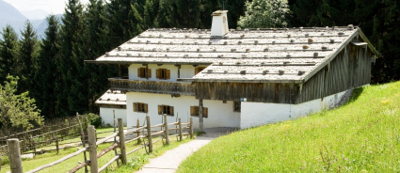 By Howie Scarboro, SnoBlox-SnoJax
By Howie Scarboro, SnoBlox-SnoJax
Primitive methods of snow retention date back centuries to Europe. Even then, sliding snow and ice was a concern because of the extensive damage it could cause to roofs and the harm it could bring to pedestrians below. As a remedy, stones and logs were often used to control the movement of snow and ice.
| |  |
| | Primitive but effective, early efforts at preventing snow avalanches on roofs involved placing rocks or logs on the roof. |
| |  |
| | |
| |  |
Stones were used in a “Field Style” layout by locating them in multiple rows spread across the entire roof surface, holding the snow and ice in place to help minimize the potential for snow avalanches. The held-in-place snow on the roof also helped create an insulating layer from the cold outside air. Logs meanwhile were used to create a “Fence” type of system. The “Fence Method” was also a very effective way to control the movement of the snow and ice until it could safely melt off. Logs were placed horizontally across the roof in fewer rows than the “Field Method” would use. Availability of local raw materials played a major role in determining which methods were to be used.
The basic strategies of snow retention remain much the same today as they did throughout history. Placing multiple rows spaced evenly up the slope is still the best method of snow retention. What has changed quite dramatically are snow retention products themselves. Stainless steel, aluminum, polycarbonate and advanced injection molding processes have brought a wide range of quality snow retention products to the marketplace.
Today’s most popular method is pad style snow guards that can be attached with either screws or adhesive. When properly used, these will create a “Field” type layout with multiple rows spaced evenly up the slope of the roof. They are very versatile and can be used on today’s exposed fastener roofs as well as standing seam panels. They are available in several styles, shapes and sizes. Some are designed to mount in the flat part of the panel while others are able to straddle over the minor ribs. Yet a third type mounts to the standing seam ribs themselves. Pad style systems are usually the least expensive method of snow retention.

| |
The modern-day version of field-style snow retention systems can involve pad-style snow guards made of many different materials, including polycarbonate, as shown above. These guards were manufactured by SnoBlox-SnoJax, an industry pioneer in the polycarbonate snow guard development. SnoBlox-SnoJax offers an AIA-accredited educational course about snow retention called Modern Snow Retention Products and Installation Methods. It can be viewed at www.snowretention101.com. | |
Bar systems are also a popular method and today’s contractor has a wide range of styles, materials, and finishes to choose from. A typical bar system will attach to the ribs of standing seam panels with non-penetrating clamps. Once all the clamps are properly torqued, the bars are loaded into the clamps and attached in various ways to create a continuous bar from one end of the roof to the other. Although bar systems are popular on floating standing seam roofs, they can also be used on slate, exposed fastener metal panels, asphalt shingle, and membrane roofs as well.
| |  |
| | Another useful product for preventing the type of damage that can be caused by the buildup of snow and ice on the roof is the SnoBlox-SnoJax Vent Saver. Featuring penetration-free attachment, it reinforces vent pipes to keep the upslope weight from pushing the pipe over. |
There are also various special use products available to solve some vent pipe issues many people experience each year. The most common damage we see is broken plumbing vent pipes and chimney pipes. A vent protector device can be used on exposed fastener roofs and also on standing seam roofs with the use of an adaptor plate to avoid penetrating the panels.